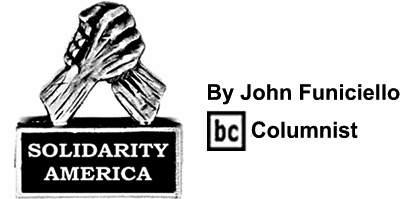
A Divided People is What Makes
The U.S. a Suffering Country



One doesn’t have to look
far to see how difficult it is in a country as big and diverse as the
Everywhere one looks,
there is division. It’s almost a clich� at this time in our history, that this
is a divided nation. The
In fact, Senator Mitch
McConnell, R-Kentucky, stood in Washington and stated in public at the outset
of the first Obama Administration that his party’s primary function for the
foreseeable future was to make him a one-term president. He was not interested
in the creation of jobs or even advancing the GOP rallying cry of “smaller
government!” He just wanted to get rid of Obama. Now, that’s division.
The overriding myth of
With a set of founding
documents as excellent as those of the
It just does not work that
way, and it’s because the people are divided into innumerable groups and
regions and blocks and it is on only rare occasions that they come together to
address any of the problems that they face. One thing that should draw the
people together is this: We are a working people. When we can, we have jobs.
Out of a population of 315
million, there are about 155 million wage earners, so one would think that this
is the place where people would find some common ground, a place from which to
unite to serve the needs of the greatest number.
While it is true that
millions of workers have joined together to better their lives, in unions, they
represent only about 11 percent of working people. (Just to make it clear, we
are talking about people who work for a paycheck and depend on that paycheck,
week to week, to support themselves and their families, whether they are paid
$20,000 or $100,000 a year.) The rule of thumb here is that, if you cannot
survive at your current standard of living for three months without a paycheck,
you are basically in the working class, like it or not.
The
Do we wonder why our sons
and daughters face one of the great obstacles of their lives, when they
graduate and can’t find jobs to pay off the 20-year (or more) debt they
incurred to get that education? When students have protested, have they had the
support of the previous generations? Not much, except perhaps for their
parents. Others in the older generations look at it as their problem. That’s
division on a generational scale. And, vice versa, when Social Security,
Medicare, and Medicaid are threatened with cuts, privatization, or elimination,
the old folks are on their own (although there are lots of them), because the
younger generation has been convinced by right-wingers in politics and the economy
that the programs are going broke and will not be there for them. Even though
these threats have been debunked many times, many believe what they hear.
Working men and women,
responding to the propaganda they hear and see every day, find it difficult to
make common cause with each other about their own standard of living. Non-union
workers often say that unionized workers make too much, and the message there
is: “If unionized workers made less, we might make more.” This is living in a
fantasy world, because workers’ families will only see an improvement in their
standard of living by fighting for it, and that means getting involved in the
political process. Simply voting is not involvement in the political process;
it’s merely a start. Involvement in the political life of a nation means
learning the issues, learning about the functioning of government, learning
about how the combination of government and powerful corporations have come to
rule most aspects of Americans’ lives.
Within the union movement,
as in the society at large, there have been divisions and those divisions
remain. Outside of uniting for better pay and wages, working people do not
agree on all issues. Historically, there has been a tension between jobs and
the environment. Many unions believed that any construction job or any program
that provided jobs was good. Many unions were concerned about the degradation
of the environment. The tension between those union factions remains. About 40
years ago, for a time, there was discussion among the unions about that great
divide and how to reduce or eliminate it, but it never happened.
Today, the best example of
that union struggle is the Keystone XL pipeline, which would bring highly toxic
“tar sands” oil from
Reversing climate change
and global warming is vital to the continued existence of the planet as we know
it, but to hear bosses of the fossil fuel industry, their public relations
people, and their politicians, their primary goal and the goal of the nation is
and always will be making a profit (“keeping the economy growing”), which means
continuing to exploit the resources without regard for the aftermath of
destruction. All one has to do is look at the destruction of the boreal forests
of
Yet, a significant
proportion of Americans are either oblivious to the problems or they believe
the climate-change deniers, who say that everything is alright and that we
should just proceed with our way of life: suburban development, malls,
Interstate highways, and the endless consumption of goods (most of which are
disposable) from China and other low-wage countries, all based on fossil fuel
burning.
The problems of the U.S. are not easily solved because most people do not know the issues and, even if they were inclined to cooperate with one another, they would have to be taught anew how a democracy works and what the individual citizen has to do to make it work for everybody. That would be okay, but we do not have much time to address some of the most troubling and dangerous issues.
The social problems are
immense and will not be solved by 50 different states taking 50 different paths
to solutions. We tried that in the fights for civil rights. Most called it
freedom and some called it “states’ rights,” and we know how that worked out: The
struggle continues for full freedom for all. Divisions exist in our quest for
quality education, universal health care, a clean up of the water and air,
housing for the poor and working class, and for solutions to problems
associated with our food system. The latter problem involves: The increasing
poverty rate in
The divisions are with us
by the thousands. One of those divisions is the seeming division between two
political parties. Although, the stream of history shows that the two parties
are pushing the
If there is one thing that
the Occupy movement accomplished, it was that it brought into the public
discourse what people have known instinctively for many generations, namely
that the biggest division is between the 1 percent and the rest of us, the 99
percent. There is little division among the 1 percent, economically or politically,
because they know that, in a democracy, the majority is supposed to rule. Since
they are in the vast minority and this country still has a democratic form,
they could see their power slip away and with it, their riches. They have been
very creative in constructing divisions among the massive majority within that
democratic political system.
Over generations, they
have managed to use those divisions to maintain their power and, therefore,
their wealth. They pick politicians and ensure that they will remain in office,
usually through bribes called political campaign contributions, and the
politicians always remember who put them where they are and what they must do
to stay there. Those contributors write the laws that their politicians
dutifully introduce, support and defend, and eventually pass into law. The
people, the vast majority, do not have the same kind of power because they are
divided, not into parts, but into fragments. No power emanates from those small
fragments.






